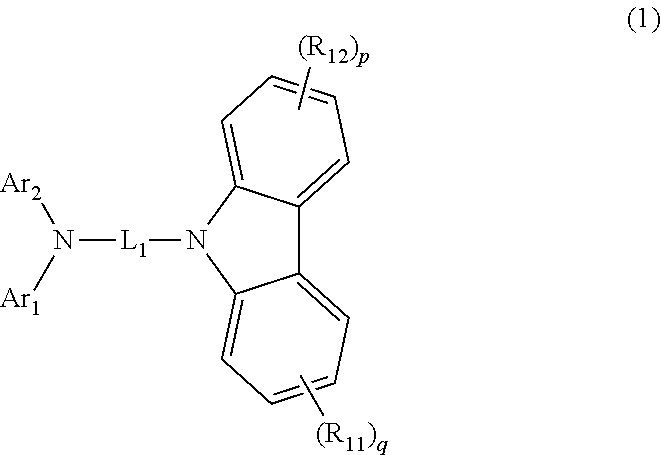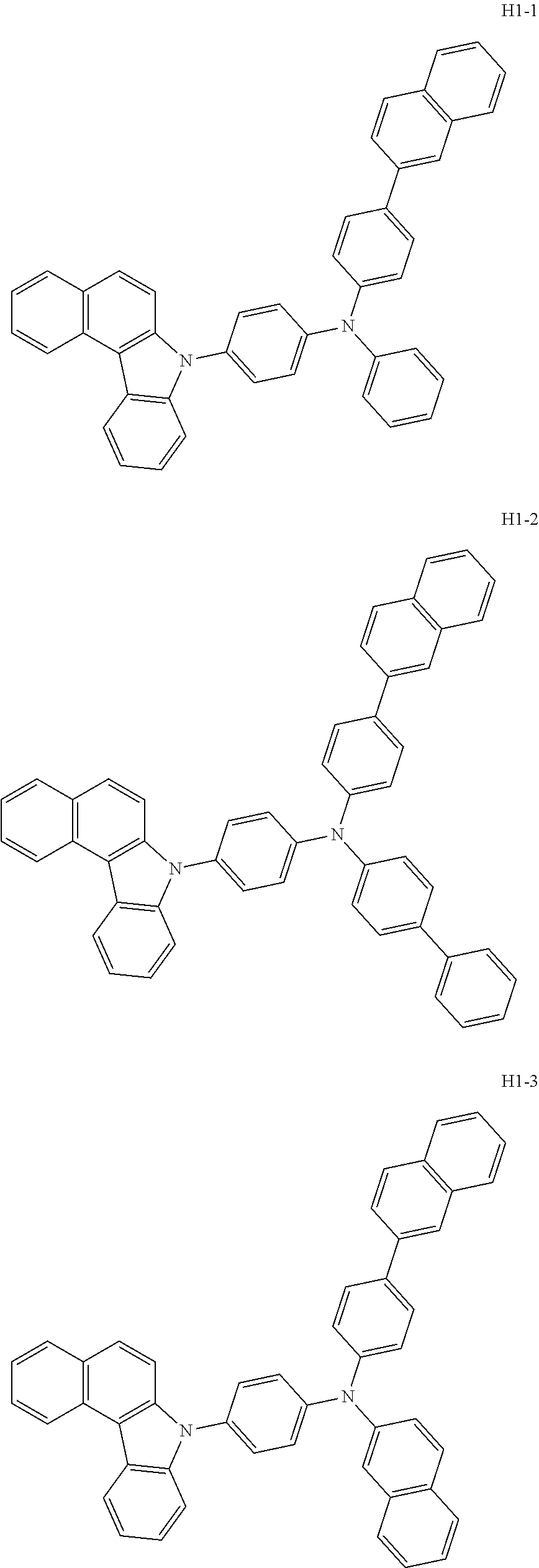Plurality of host materials and organic electroluminescent device comprising the same
- Summary
- Abstract
- Description
- Claims
- Application Information
AI Technical Summary
Benefits of technology
Problems solved by technology
Method used
Image
Examples
example 1
on of Compound H2-22
[0062]
[0063]Synthesis of Compound 1-1
[0064]2-chloro-4,6-di(naphthalen-2-yl)-1,3,5-triazine (20 g, 79.7 mmol), (4-bromonaphthalen-1-yl)boronic acid (32.2 g, 87.7 mmol), Pd(PPh3)4 (4.6 g, 3.985 mmol), and Cs2CO3 (65 g, 199.25 mmol) were dissolved in 400 mL of toluene in a flask, and the mixture was stirred under reflux for 4 hours. After completion of the reaction, the reaction mixture was cooled to room temperature, an organic layer was extracted with ethyl acetate, and the residual moisture was removed using magnesium sulfate. The residue was dried, and separated by column chromatography to obtain compound 1-1 (30 g, yield: 74%).
[0065]Synthesis of Compound H2-22
[0066]Compound 1-1 (10 g, 19.7 mmol), 9H-carbazole (3.0 g, 17.9 mmol), tris(dibenzylideneacetone)dipalladium(0) (0.8 g, 0.9 mmol), dicyclohexylphosphino-2′,6′-dimethoxybiphenyl (s-phos) (0.73 g, 1.79 mmol), and sodium tert-butoxide (4.3 g, 44.75 mmol) were dissolved in 90 mL of xylene in a flask, and the m...
example 2
on of Compound H2-115
[0067]
[0068]Synthesis of Compound 1-2
[0069]4-bromo-9H-carbazole (10 g, 40.6 mmol), phenylboronic acid (6.2 g, 48.7 mmol), Pd(PPh3)4 (2.3 g, 2.03 mmol), and Na2CO3 (13 g, 121.8 mmol) were dissolved in 200 mL of toluene, 100 mL of ethanol, and 100 mL of water in a flask, and the mixture was stirred under reflux for 3 hours. After completion of the reaction, the reaction mixture was cooled to room temperature, an organic layer was extracted with ethyl acetate, and the residual moisture was removed using magnesium sulfate. The residue was dried, and separated by column chromatography to obtain compound 1-2 (9 g, yield: 91%).
[0070]Synthesis of Compound H2-115
[0071]Compound 1-1 (8.5 g, 13.5 mmol), compound 1-2 (3.0 g, 12.3 mmol), Pd2(dba)3 (0.56 g, 0.615 mmol), s-phos (0.51 g, 1.23 mmol), and NaOtBu (2.9 g, 30.75 mmol) were dissolved in 60 mL of o-xylene in a flask, and the mixture was stirred under reflux for 4 hours. After completion of the reaction, the reaction mi...
example 3
on of Compound H2-14
[0072]
[0073]4-phenyl-9H-carbazole (3.0 g, 12.3 mmol), 2-(4-bromonaphthalen-1-yl)-4,6-diphenyl-1,3,5-triazine (5.4 g, 12.3 mmol), Pd2(dba)3 (0.56 g, 0.62 mmol), s-phos (0.51 g, 1.23 mmol), and NaOtBu (2.4 g, 24.7 mmol) were dissolved in 62 mL of o-xylene in a flask, and the mixture was stirred under reflux for 6 hours. After completion of the reaction, the reaction mixture was cooled to room temperature, and MeOH was added thereto, while stirring it at room temperature, to produce a solid. The solid was filtered under reduced pressure, extracted with MC / Hex, and separated by column chromatography to obtain compound H2-14 (3.3 g, yield: 45%).
PUM
 Login to View More
Login to View More Abstract
Description
Claims
Application Information
 Login to View More
Login to View More - R&D
- Intellectual Property
- Life Sciences
- Materials
- Tech Scout
- Unparalleled Data Quality
- Higher Quality Content
- 60% Fewer Hallucinations
Browse by: Latest US Patents, China's latest patents, Technical Efficacy Thesaurus, Application Domain, Technology Topic, Popular Technical Reports.
© 2025 PatSnap. All rights reserved.Legal|Privacy policy|Modern Slavery Act Transparency Statement|Sitemap|About US| Contact US: help@patsnap.com



